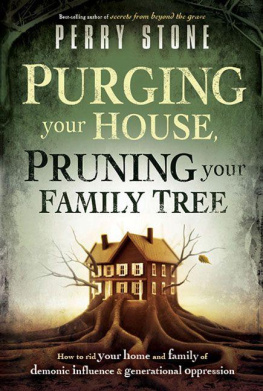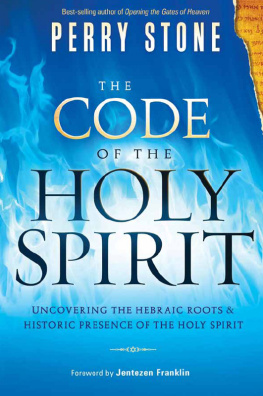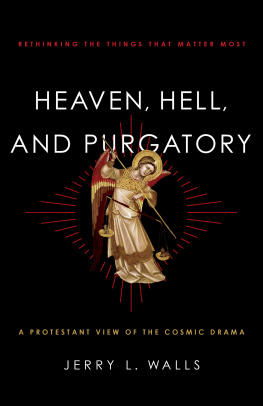Chapter 1
Journey
There are three worlds, one seen and two unseen. Yet the unseen realm is as real and tangible as the seen. These three dimensions are written about in the following passage:
That at the name of Jesus every knee should bow, of things in heaven, and things in earth, and things under the earth.
--Philippians 2:10, KJV
"Things in earth" are living human beings. "Things in heaven" include God, Christ, and the angels. "Things under the earth" include chambers where fallen angels are bound in chains of darkness while waiting for the day of their judgment (2 Pet. 2:4). According to the New Testament, there are also the souls and spirits of departed men and women, some being reserved in a special region in heaven and others in chambers located under the earth.
The location of those now residing in heaven is identified by the apostle Paul as a heavenly paradise, alluded to in 2 Corinthians 12:1-4. The opposite holding chambers , known as the land of the departed unrighteous souls, are located under the earth and include a series of large caverns and chambers, deep under the crust of the mountains, where the unrighteous souls and spirits are taken immediately following their physical death on Earth. (See Numbers 16:30-33; Luke 16:23-31.)
The Creation of the Underworld
Moses recorded that, "In the beginning God created the heavens and the earth" (Gen 1:1). Prior to when God formed Adam in the Garden of Eden, angels preexisted with God and were watching the activities of Creation as the Almighty spoke it into existence (Job 38:4-7). Some scholars point out that in Genesis 1:1, the Hebrew word for "created," which is bara (baw-raw), indicated the heavens and Earth were formed in a perfected condition.
However, in Genesis 1:2 we read that the "earth was without form, and void; and darkness was on the face of the deep." Darkness is on the "deep." The Hebrew word for "deep" is tehom and alludes to the subterranean chambers under the earth where the waters are stored. This apparent chaos seen in verse 2 has been identified among some biblical students as the time of the fall of Satan and his angels from heaven (Isa. 14:12-15; Luke 10:18; Rev. 12:7-10), thus causing a chaotic event to occur on the earth.
Thus, between the mysterious and unknown "ages past" of Genesis 1:1 and the fall of Satan in Genesis 1:2, the expulsion of Satan from heaven to Earth struck the planet like lightning (Luke 10:18), and, as some suggest, this was the time when God created a place called hell in the heart of the earth. It is clear that hell was never created for man but originally was intended only for Satan and his rebellious angels. We read in Matthew 25:41:
Then He will also say to those on the left hand, "Depart from Me, you cursed, into the everlasting fire prepared for the devil and his angels."
While the details of the expulsion of Satan from heaven and the creation of hell remain somewhat of a mystery, the waters covering the earth in Genesis 1:2 are believed by some to be the waters cooling the planet down after chamber after chamber of hell had been formed in the center of the earth. Oddly, there are scientists who believe the earth was at one time a ball of fire that eventually cooled (with water) and formed the planet we now dwell on. The difference between what I am sharing and the scientific "slow-evolving planet theory" of the earth is the time element. Scientists believe the formation process took billions of years. However, although in ages past the original Creation of Genesis 1 may have occurred millions of years ago, the time frame recorded from Genesis 3:3 onward--of God creating the light, plants, and man--was slightly more than six thousand years ago according to traditional theology. Whether hell was prepared before the fall of Satan (Gen 1:1) or afterward (Gen 1:2), Scripture and science agree on these facts: there are different levels under the earth, and the center of the earth is fire.
The Underground Chambers
Throughout the Bible there are five different words used to identify the area I call the underworld: These words are:
- Sheol --an Old Testament Hebrew word
- Hades --a New Testament Greek word
- Gehenna --a New Testament Greek word
- Tartaroo --a New Testament Greek word
- Abyss --a New Testament Greek word
The word Sheol is used sixty-five times in the Old Testament. It is translated as " hell" thirty-one times in the Bible, thirty-one times as " grave ," and three times as " pit ." The word Hades is translated as " hell" ten times in the New Testament. It is also found in 1 Corinthians 15:55, where the English word is grave. The only exception is Revelation 6:8. In that passage the pale horse rider is Death, and hell ( Hades ) follows him.
By definition the word Hades is "the region of departed spirits of the lost (but including the blessed dead in periods preceding the ascension of Christ)."
The early church fathers commented on Hades. One Ante-Nicene father commented:
This is the torment compartment of Sheol-Hades where wicked souls have always gone and will always go until the end of the Millennium.... Hades is a place in the created system, rude, a locality beneath the earth, in which the light of the world does not shine; and as the sun does not shine in this locality, there must necessarily be perpetual darkness there.
The third word, tartaroo , is a Greek word translated as "hell" and found in only one place:
For if God did not spare the angels who sinned, but cast them down to hell and delivered them into chains of darkness, to be reserved for judgment...
--2 Peter 2:4
Tartarus was considered both a spirit or a deity in Greek mythology and the place of a chamber lower than Hades in which the most wicked spirits were confined. It was believed to be the first place created in the regions of the underworld, as angels fell into sin ages before Adam was created and sinned. Peter reveals that this is the chamber of the fallen angels.
Just as Satan will be cast into the abyss in the future and have a seal placed over the pit preventing his escape for one thousand years (Rev. 20:3), so those angels who were in revolt against God during the fall of Lucifer and those who corrupted themselves in the days of Noah by producing the offspring of giants (Gen. 6:4) are now chained in pits of darkness in the lowest parts of the earth. There is no indication that human souls are in this region, but only fallen angels. Jude wrote:
And the angels who did not keep their proper domain, but left their own abode, He has reserved in everlasting chains under darkness for the judgment of the great day.
--Jude 6
The next word revealing another chamber under the earth is the Greek word abussos , which is translated in English as the word abyss . This word is found nine times in the New Testament and is translated in the Book of Revelation as "bottomless pit" (Rev. 9:1-2, 11; 11:7; 17:8; 20:1, 3). This word alludes to an unspecified area under the earth that is a huge void, an empty cavity that cannot be measured. This place was known to the evil spirit Christ encountered during His ministry. On one occasion, Christ expelled a large host of demons from a man, and the chief evil spirit requested not to be confined in the "deep" (Luke 8:31, KJV ). The King James Version says "deep," but the Greek word is abussos , or the abyss. Thus, as far back as almost two thousand years ago, the world of fallen and evil spirits under Satan's authority was fully aware of their final doom--the abyss.
The spirit world knows the Scriptures, as evidenced during Christ's temptation when Satan quoted from Psalm 91. (Compare Psalm 91:11-12 with Matthew 4:6.) The prophet Isaiah predicted that Lucifer would one day "be brought down to hell, to the sides of the pit" (Isa. 14:15, KJV ). In Christ's time, the evil spirits He encountered knew that their final doom would be confinement in a "pit." Perhaps after seeing Christ, they believed the time of their destruction had arrived!
Next page












